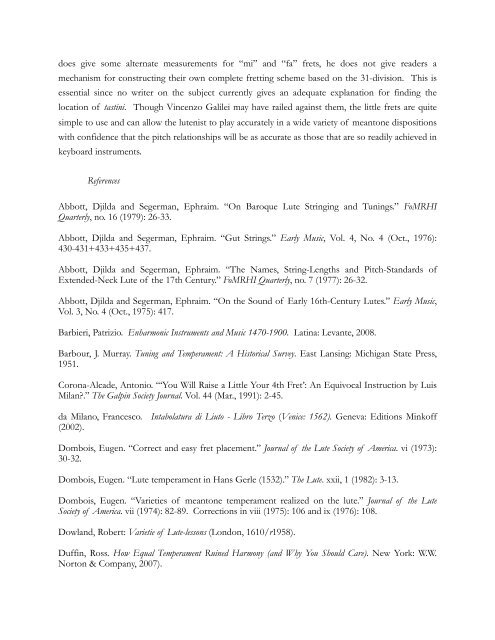the-rule-of-31
the-rule-of-31
the-rule-of-31
You also want an ePaper? Increase the reach of your titles
YUMPU automatically turns print PDFs into web optimized ePapers that Google loves.
does give some alternate measurements for “mi” and “fa” frets, he does not give readers a<br />
mechanism for constructing <strong>the</strong>ir own complete fretting scheme based on <strong>the</strong> <strong>31</strong>-division. This is<br />
essential since no writer on <strong>the</strong> subject currently gives an adequate explanation for finding <strong>the</strong><br />
location <strong>of</strong> tastini. Though Vincenzo Galilei may have railed against <strong>the</strong>m, <strong>the</strong> little frets are quite<br />
simple to use and can allow <strong>the</strong> lutenist to play accurately in a wide variety <strong>of</strong> meantone dispositions<br />
with confidence that <strong>the</strong> pitch relationships will be as accurate as those that are so readily achieved in<br />
keyboard instruments.<br />
References<br />
Abbott, Djilda and Segerman, Ephraim. “On Baroque Lute Stringing and Tunings.” FoMRHI<br />
Quarterly, no. 16 (1979): 26-33.<br />
Abbott, Djilda and Segerman, Ephraim. “Gut Strings.” Early Music, Vol. 4, No. 4 (Oct., 1976):<br />
430-4<strong>31</strong>+433+435+437.<br />
Abbott, Djilda and Segerman, Ephraim. “The Names, String-Lengths and Pitch-Standards <strong>of</strong><br />
Extended-Neck Lute <strong>of</strong> <strong>the</strong> 17th Century.” FoMRHI Quarterly, no. 7 (1977): 26-32.<br />
Abbott, Djilda and Segerman, Ephraim. “On <strong>the</strong> Sound <strong>of</strong> Early 16th-Century Lutes.” Early Music,<br />
Vol. 3, No. 4 (Oct., 1975): 417.<br />
Barbieri, Patrizio. Enharmonic Instruments and Music 1470-1900. Latina: Levante, 2008.<br />
Barbour, J. Murray. Tuning and Temperament: A Historical Survey. East Lansing: Michigan State Press,<br />
1951.<br />
Corona-Alcade, Antonio. “‘You Will Raise a Little Your 4th Fret’: An Equivocal Instruction by Luis<br />
Milan?.” The Galpin Society Journal. Vol. 44 (Mar., 1991): 2-45.<br />
da Milano, Francesco. Intabolatura di Liuto - Libro Terzo (Venice: 1562). Geneva: Editions Mink<strong>of</strong>f<br />
(2002).<br />
Dombois, Eugen. “Correct and easy fret placement.” Journal <strong>of</strong> <strong>the</strong> Lute Society <strong>of</strong> America. vi (1973):<br />
30-32.<br />
Dombois, Eugen. “Lute temperament in Hans Gerle (1532).” The Lute. xxii, 1 (1982): 3-13.<br />
Dombois, Eugen. “Varieties <strong>of</strong> meantone temperament realized on <strong>the</strong> lute.” Journal <strong>of</strong> <strong>the</strong> Lute<br />
Society <strong>of</strong> America. vii (1974): 82-89. Corrections in viii (1975): 106 and ix (1976): 108.<br />
Dowland, Robert: Varietie <strong>of</strong> Lute-lessons (London, 1610/r1958).<br />
Duffin, Ross. How Equal Temperament Ruined Harmony (and Why You Should Care). New York: W.W.<br />
Norton & Company, 2007).



